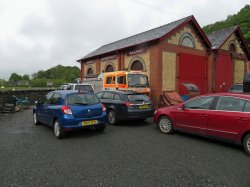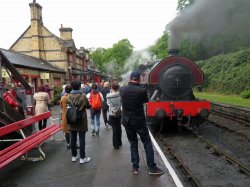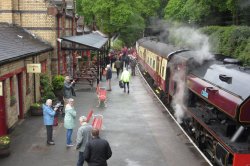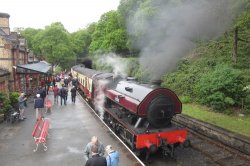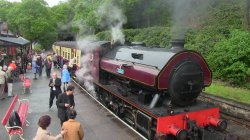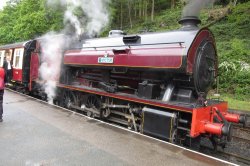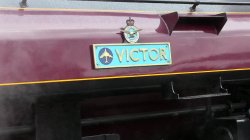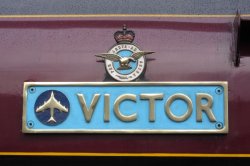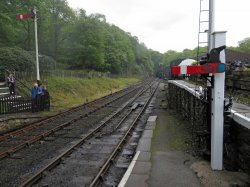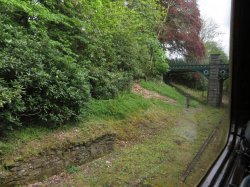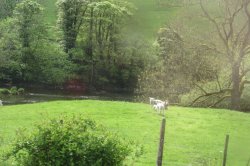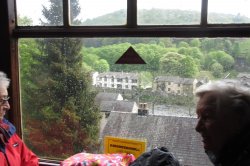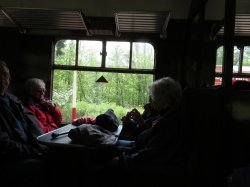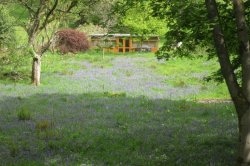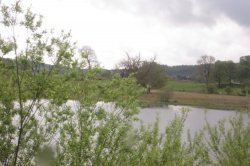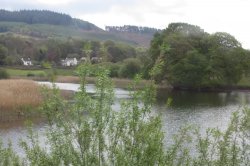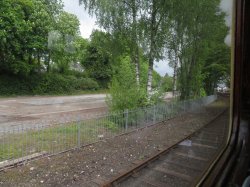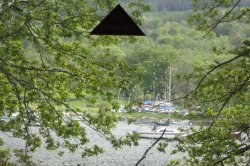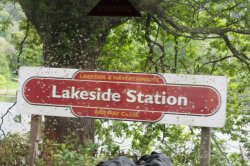When the various companies had completed a railway system around the coast from Carlisle to Lancaster, the Furness Railway Company quickly realised that there was a potential for personal travel and tourism because, for the first time, here was a fast and easy mode of transport for the masses. In fact, as early as 1847, the Kendal and Windermere Railway Company had opened a branch line from the new Lancaster and Carlisle Railway; this branch from Oxenholme terminated at Birthwaite (which was later to develop as the modern town of Windermere), and by 1850, four passenger steamers plied the length of the lake from Waterhead to Newby Bridge (a distance of about 11½ miles).
CONSTRUCTION
The Furness Railway, with an eye to the future built a line from Plumpton Junction (near Ulverston) along the River Leven estuary to Greenodd. A final decision was then made to build an extension up the valley to Newby Bridge, so on the 22nd November 1866, Mr. James Ramsden, the General Manager of the Furness Railway and a major landowner and industrialist, cut the first sod at Haverthwaite.
Construction of the line commenced the following year, but the difficult tunnelling and cutting through the hard rocks around Haverthwaite soon put the work behind schedule. Meanwhile, a decision was made to extend the line beyond Newby Bridge with a new terminus at Lakeside a mile further on, which would allow larger steamers to operate. Shares were purchased in the Windermere United Steam Yacht Co. to prevent any possible expansionist plans of the Kendal and Windermere Railway which by now was part of the London & North Western Railway. The intentions of the Furness Railway Company were now very clear.
The line, of 7 miles and 73 chains (7.9 miles or 12.7km), was opened with great ceremony on the 1st June 1869, although the stations along the route were not yet completed.
REVENUE
The main revenue earner for the line was freight, this being coal for the Windermere steamers, iron ore for the Backbarrow Iron Works, and sulphur and saltpetre for the Black Beck and Low Wood gunpowder works. The traffic in the opposite direction was mainly pig iron, gunpowder, pit props, ultramarine ‘blue’ powder, wooden bobbins (from the Finsthwaite area) and livestock.
CLOSURE
By 1872, the steamers of the United Windermere Steam Yacht Company had been purchased outright by the Furness Railway but unfortunately, at the same time the iron ore industry started to decline and, with it, the fortunes of the Furness Railway.
At the turn of the century, with a more modern fleet of vessels on the lake, the Furness Railway was in an ideal position to encourage and carry train loads of day trippers and holiday-makers. The golden years of the branch had begun, and were to reach a peak just before the Great War, the traffic gradually tailing off as the motor car became more popular.
Unfortunately, during the period between closure in 1965 and re-opening in 1973, most of the Lakeside station was demolished apart from the quayside office of Sealink and the Cafeteria above. The overall roof was the last to go, this being removed as unsafe by the owners of the site (British Rail Property Board) during the winter of 1978, so that sadly, little now remains to remind the visitor of the station in its Edwardian heyday.?
SALVATION
In the early 1960’s, Mr Austin Maher, a Lancashire businessman was talking to his brother Charles, a farmer living near Kendal about the forthcoming end of steam on British Railways and the subsequent scrapping of their steam locomotives.
As both men were keen cine-photographers, Austin suggested to his brother that he might like to take some film on Shap Fell while on his regular run to Penrith cattle Market, thus providing a photographic record before steam was gone forever.
Late in the summer of 1965, Charles accompanied Mr Taffy Owen, an engine driver friend from Carnforth shed, on the footplate of class 5 locomotive No. 45227, hauling a special train know as the “Lake Windermere Cruise” from Blackpool to Lakeside.
The journey enabled a film of the branch to be made before closure. Early in 1966, when showing this film to friends in Carnforth, the brothers were introduced to Dr. Peter Beet and Mr John Parkin, who had previously expressed an interest in forming a company to save the branch and to eventually re-open it using steam traction.
PURCHASE
On the 27th May, 1970, the BR Property Board approved the sale of the line, provided that a light railway order be granted to British Railways, and a transfer order then be granted to the Lakeside and Haverthwaite Railway Company, and that guarantees be given that finance was available for the purchase.
The Lakeside Railway Society was granted access to the line for tidying up purposes, and in October 1970, coaches (purchased from British Railways at York) were delivered to the line together with the available locomotives which had been stored at Carnforth. This movement was precipitated by the impending lifting of the remainder of the line, which actually took place in June 1971.
After many changes in the ownership it was eventually purchased by Mr. Austin Maher who had also been responsible for funding all the administration expenses of the previous years. Major P. M. Olver of the Railway Inspectorate then examined every aspect of the line and its proposed operating methods, giving his clearance for the reopening to passenger traffic.
RE-OPENING
The re-opening on the 2nd May 1973, was a proud day for the Society members who had worked so hard to repair and restore the railway to the necessary operating standards and for the Company’s directors, its shareholders and friends it was a dream realised. A moment to be savoured by the now Chairman, Mr. Austin Maher, was when he asked Britain’s best known railway photographer, the Right Reverend Eric Treacy, LLD, Bishop of Wakefield, to cut the tape linking the lake steamer to locomotive 42085, which was at the head of the inaugural special train, together with its sister engine 42073. En-route to Haverthwaite a stop was made at Newby Bridge Halt, where the Bishop planted a copper beech tree to commemorate the beginning of a new life.
For further information can be found on the website - www.lakesiderailway.co.uk
 LAKESIDE & HAVERTHWAITE RAILWAY
LAKESIDE & HAVERTHWAITE RAILWAY
